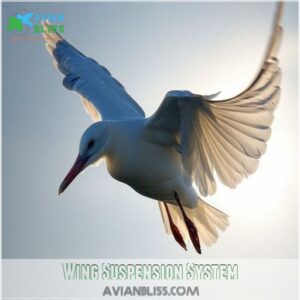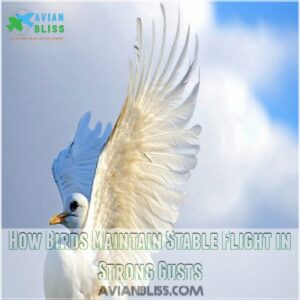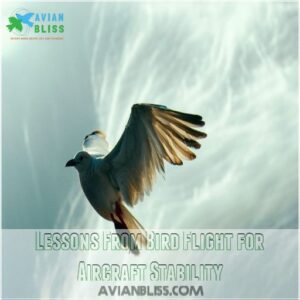This site is supported by our readers. We may earn a commission, at no cost to you, if you purchase through links.
 You’ll be amazed at how birds fly in strong winds – they’re nature’s master pilots.
You’ll be amazed at how birds fly in strong winds – they’re nature’s master pilots.
They tuck their wings closer to their bodies and adjust their shape to reduce drag, like a fighter jet switching to stealth mode.
When facing headwinds, they’ll fly lower where the air is calmer, using tree lines and buildings as windbreaks.
They’re also masters at using updrafts and wind currents to their advantage, turning what seems like a challenge into free transportation.
Birds can even lock their wings in place to minimize energy use, much like you’d put your car in cruise control.
Their survival techniques go far beyond these basics.
Table Of Contents
- Key Takeaways
- Bird Flight Mechanics
- How Birds Fly in Strong Winds
- Physical Adaptations for Windy Conditions
- Flight Techniques in Strong Winds
- Examples of Birds That Excel in Windy Conditions
- How Birds Maintain Stable Flight in Strong Gusts
- Lessons From Bird Flight for Aircraft Stability
- Frequently Asked Questions (FAQs)
- How do birds fly?
- Why do birds fly in strong winds?
- How do birds survive in strong winds?
- Can birds fly if it’s Windy?
- Why do birds spread their wings?
- Why do birds fly so well?
- Where do birds go when it is extremely windy?
- Do birds have trouble flying in the wind?
- What bird stays in the air for 5 years?
- How do birds not get tired of flying?
- Can birds predict when strong winds will occur?
- What wind speeds force birds to stop flying?
- Do birds get tired faster flying against wind?
- How do baby birds learn wind navigation skills?
- Which direction do most birds prefer flying in?
- Conclusion
Key Takeaways
- You’ll find birds adjusting their wing shape and position constantly, tucking them closer to reduce drag and flying lower where the air is calmer.
- Your feathered friends use their hollow bones and powerful chest muscles (15-25% of body mass) to maintain control while staying lightweight.
- You can spot birds using four key forces in flight: lift pushes up against gravity, while thrust powers forward motion against air resistance.
- You’ll notice birds conserving energy by locking their wings in place and using updrafts as free transportation, turning strong winds to their advantage.
Bird Flight Mechanics
You’ll find that birds are masters of flight mechanics, using their specialized wing shapes and strong muscles to generate lift and thrust in challenging winds.
When you watch them closely, you’ll notice how they’re constantly adjusting their wings and tail feathers to maintain balance, much like a pilot controls an aircraft’s flaps and rudder.
Aerodynamics and Lift
When you watch birds soar through gusty winds, you’re witnessing Bernoulli’s Principle in action.
As air moves faster over a bird’s curved wing than under it, it creates lift – nature’s own magic trick.
Here’s how they stay airborne in strong winds:
- Wing shape adjusts to minimize air resistance
- Flight feathers spread or contract to control lift
- Updraft utilization allows effortless soaring
Understanding these principles helps explain their remarkable aerial abilities.
Anatomy and Physiology
Birds pack an incredible array of specialized features into their compact frames.
You’ll find hollow bones that cut weight while maintaining strength, and powerful flight muscles that make up 15-25% of their total mass.
Their respiratory system is a marvel too – with air sacs extending into those hollow bones, they’re basically breathing machines built for high-performance flight in any conditions.
Forces of Flight
Just like a plane needs perfect balance to stay airborne, four key forces keep your feathered friends soaring through strong winds.
Lift pushes upward against gravity’s pull, while thrust powers forward motion against air resistance.
Picture a tug-of-war: Bernoulli’s Principle creates lift as air moves faster over the wing’s curved top, while downward thrust from wing angles helps counter those gusty challenges.
Wing Shape and Structure
Through masterful wing design, flight forces become a symphony of motion. You’ll notice every part of a bird’s wing works together, from the curved leading edge to the perfectly aligned feathers. The wing’s shape changes constantly during flight, adapting to air currents like a well-choreographed dance.
- The wing’s aspect ratio (length vs width) determines flight efficiency and maneuverability
- Feather arrangement creates an airtight surface during downstrokes
- Wing loading (weight vs wing area) affects how birds handle strong winds
How Birds Fly in Strong Winds
Ever watched a flock of starlings dance through fierce winds like skilled aerial acrobats? It’s a masterclass in nature’s engineering. When strong gusts hit, birds employ remarkable strategies to stay airborne: They often first seek shelter to wait out the storm, utilizing natural shelter options.
- They lean into headwinds, using the force to gain extra lift
- They adjust their wing angles constantly, like a pilot fine-tuning controls
- They reduce their profile by tucking in wings closer to their bodies
- They zigzag strategically, riding wind currents instead of fighting them
Think of it as nature’s version of defensive driving – birds don’t just survive in strong winds, they’ve learned to use them to their advantage.
Physical Adaptations for Windy Conditions
You’ll find birds have incredible physical features that help them handle strong winds, including hollow bones that reduce their weight and powerful chest muscles that give them exceptional control during flight.
Their wing design works like a natural suspension system, allowing them to adjust their wing shape and position to stay stable even when facing heavy gusts and turbulence.
Wing Suspension System
Birds’ wing suspension system acts like a sophisticated shock absorber, helping them navigate turbulent winds with remarkable precision.
You’ll find their wing structure specially designed to flex and twist, much like a car’s suspension system handles bumpy roads.
| Wing Component | Function in Wind |
|---|---|
| Elastic ligaments | Absorb wind shock |
| Flexible joints | Enable quick adjustments |
| Feather shafts | Bend without breaking |
| Layered coverts | Reduce turbulence |
| Wing muscles | Control flex response |
Hollow Bones and Lightweight Bodies
You’d be amazed at the evolutionary advantage behind a bird’s skeletal structure.
Like nature’s own carbon fiber design, hollow bones provide remarkable strength while keeping weight to a minimum.
These pneumatic bones are filled with air sacs, reducing overall mass by up to 40%.
Researching products like the lightweight bird skeleton models can help illustrate this unique characteristic.
When strong winds blow, this lightweight frame helps birds maintain control and adjust their flight path with less effort.
Strong Muscles and Large Lungs
Birds also possess incredible vertical takeoff abilities, with some species like hummingbirds and ducks using unique techniques such as wing-slapping and tail feather-pushing, which contribute to their overall flight capabilities. The powerhouse behind a bird’s ability to tackle strong winds lies in its remarkable flight muscles and respiratory system.
Working like a well-oiled machine, these muscles can make up to 30% of a bird’s total body weight.
Large, efficient lungs process oxygen faster than any other vertebrate, while a unique system of air sacs helps birds maintain steady breathing even during the most challenging aerial maneuvers.
Counter-Current Exchange in Legs
When temperatures drop, counter-current exchange in birds’ legs acts like a natural thermostat.
You’ll find arteries and veins running parallel, allowing warm arterial blood to heat the cooler venous blood returning from the feet.
Birds also stand on one leg to conserve heat through a process called thermoregulation technique, reducing heat loss by tucking one leg close to their body.
This clever system helps birds conserve heat while standing on cold surfaces or battling strong winds, making it easier to maintain flight readiness in challenging conditions.
Flight Techniques in Strong Winds
You’ll find that birds use specific flight methods to handle strong winds, including changing their wing position and adjusting their body angle to maintain control.
When you watch birds in windy conditions, you’ll notice they’re constantly making these small adjustments, similar to how a pilot manages an aircraft through turbulence.
Flapping and Thrust
Birds harness flapping power to conquer strong winds, much like a boxer throwing rapid punches.
Their wingbeat frequency adapts to conditions, with muscles working overtime to generate powerful thrust.
Here’s how they master the wind:
- Fast, shallow flaps minimize air resistance
- Stiff wing positions cut through gusts
- Rapid upstrokes reduce energy loss
- Well-timed feather adjustments maintain control
These techniques let birds navigate fierce headwinds while staying stable and efficient.
Gliding and Soaring
Two remarkable flight techniques help birds conquer strong winds without expending much energy.
You’ll notice them gliding by tucking their wings close to reduce resistance, letting gravity and momentum carry them forward.
During soaring, they’ll spread their wings wide to catch thermal updrafts, rising higher with minimal effort.
These techniques let them cover vast distances while conserving precious energy reserves.
Breathing System and Oxygen Supply
A remarkable breathing system helps birds conquer strong winds at any altitude.
Unlike you and me, they’ve got air sacs that work like tiny bellows, pushing oxygen through their bodies with every wing beat.
Their high-powered metabolism needs this super-efficient oxygen delivery system to keep their muscles firing at full strength, especially when fighting against powerful gusts and turbulent air.
Adjusting Center of Gravity
Just like a tightrope walker’s balancing pole, a bird’s ability to adjust its center of gravity is key to mastering strong winds, often with the help of specialized products from a bird center gravity store products for bird balance.
You’ll notice how they shift their wing shape, tilt their heads, and reposition their tails to maintain perfect balance.
These precise movements, combined with instant feather adjustments, help them stay stable even when powerful gusts threaten to knock them off course.
Examples of Birds That Excel in Windy Conditions
You’ll find nature’s most skilled wind riders in birds like the wandering albatross and Andean condor, which can fly for hours through powerful gusts without landing.
These masters of windy conditions use their specialized wing shapes and strong flight muscles to handle storms that would ground most other birds.
Wandering Albatrosses
Out across the vast Southern Ocean, wandering albatrosses showcase nature’s perfect design for oceanic flight. With the largest wingspan of any living bird, these masters of wind resistance demonstrate remarkable adaptations:
- Wings spanning up to 11.5 feet let them glide for hours without flapping
- Dynamic soaring techniques use wind layers for effortless flight
- Heart rates nearly match resting levels while flying
- Can travel 500 miles daily using only wind energy
Andean Condors
Andean condors, nature’s masters of wind navigation, soar effortlessly through the harsh mountain winds of South America.
Their massive 10-foot wingspan and specialized wing feathers help them ride powerful thermal currents without flapping.
You’ll find these impressive birds gliding at altitudes over 16,000 feet, using their remarkable hollow bones and efficient respiratory system to thrive in low-oxygen environments where other birds can’t survive.
Great Frigatebirds
Great Frigatebirds soar effortlessly through fierce tropical winds, thanks to their impressive 7.5-foot wingspan and incredibly lightweight frame.
You’ll find these masters of oceanic flight displaying remarkable wind resistance adaptations that let them stay airborne for weeks at a time.
- Their specialized wing design allows them to harness both thermal updrafts and wind currents
- Their forked tail provides exceptional maneuverability in gusty conditions
- Their unique ability to lock their wings in place minimizes energy expenditure during long flights
American White Pelicans
American White Pelicans soar through powerful winds with remarkable grace, thanks to their impressive 9-foot wingspan.
You’ll find these magnificent birds riding thermals and gliding effortlessly, even when crosswinds kick up.
Their specialized wing muscles let them adjust their flight path instantly, while their unique pouch acts like a built-in stabilizer.
They’re masters of energy-efficient migration, covering thousands of miles by expertly reading wind patterns.
How Birds Maintain Stable Flight in Strong Gusts
You’ll be amazed at how birds use their wings like built-in shock absorbers to handle strong wind gusts, adjusting their wing shape and angle to maintain balance in turbulent air.
When facing powerful winds, they’ll tilt their bodies and spread their tail feathers while shifting their center of gravity, much like a tightrope walker uses a balance pole.
Stable Flight Mechanics
Birds soar through fierce winds with remarkable stability, thanks to their built-in flight control systems. Like a well-tuned machine, their bodies maintain equilibrium even in turbulent conditions.
- Feather arrangement shifts automatically to reduce air resistance
- Body posture adjusts continuously to maintain balance
- Tail position changes act as a natural stabilizer
- Internal air sacs help manage pressure differences
Wing Movement and Control
When strong winds howl, wing control becomes a masterpiece of natural engineering.
You’ll find that a bird’s wing movements adapt with remarkable precision, just like a skilled pilot adjusting their controls.
For those interested in the intricacies of bird wing control systems, check out these bird wing control devices.
| Movement | Purpose in Strong Winds |
|---|---|
| Feather spread | Reduces air gaps |
| Wing tuck | Minimizes resistance |
| Tail fan | Controls direction |
| Wing twist | Balances lift forces |
| Quick flicks | Counters sudden gusts |
These movements work together like a well-orchestrated dance, letting birds maintain control even in challenging conditions.
Airfoil Design and Lift
You’ve probably wondered how birds maintain their mastery of flight in gusty conditions.
The secret lies in their wings’ remarkable airfoil design, which creates lift through precise engineering that rivals modern aircraft.
Here’s how their natural wing design works:
- Curved upper surface increases air speed, reducing pressure
- Flatter bottom surface maintains steady airflow
- Variable wing positioning adapts to changing wind conditions
- Flexible feather edges fine-tune lift generation
Aerodynamic Forces and Drag
The complex interplay of aerodynamic forces on birds reveals nature’s masterful engineering.
In strong winds, a bird’s streamlined body and specialized feathers work together to minimize drag – much like a well-designed sports car cutting through air.
The way feathers overlap creates a smooth surface that reduces air resistance, while their flexible nature allows real-time adjustments to combat wind shear and maintain stability.
Lessons From Bird Flight for Aircraft Stability
Scientists and engineers draw inspiration from birds’ remarkable flight capabilities to improve aircraft design.
By studying wing flexibility and shape-shifting abilities, they’ve developed advanced flight control systems that handle turbulence better.
Birds’ natural wind shear response mechanisms, such as the unique wing morphing techniques, have led to smarter autopilot systems, while their aerodynamic efficiency influences modern aircraft wing design.
Their ability to adjust wing loading and maintain stability in gusty conditions has revolutionized turbulence mitigation technology.
Next time you’re on a smooth flight through rough weather, thank the feathered experts who helped perfect those innovations.
Frequently Asked Questions (FAQs)
How do birds fly?
Birds flap their powerful wings to create lift and thrust, utilizing specialized feathers and hollow bones for efficient flight.
They’ll adjust wing positions and body angles while riding air currents to stay airborne.
Why do birds fly in strong winds?
Nature’s skilled aviators take advantage of strong winds to conserve energy, using updrafts and air currents to soar effortlessly.
You’ll notice they’ve mastered riding these invisible highways like natural surfers in the sky.
How do birds survive in strong winds?
Through remarkable adaptations, you’ll see that these winged wonders endure fierce winds by seeking sheltered spots.
Microhabitats like tree lee sides provide protection from nature’s fury.
They also adjust their wing positions.
Can birds fly if it’s Windy?
Ducks, for instance, have strong flight muscles and aerodynamic bodies, allowing them to fly efficiently. Yes, you’ll find birds can fly in windy conditions by adjusting their wing positions and flight patterns.
They’ll use their tail feathers like a rudder, helping them navigate through strong gusts efficiently.
Why do birds spread their wings?
Like solar panels catching energy, birds spread their wings for multiple purposes: generating lift during flight, regulating body temperature, and drying their feathers.
Birds often bask in the morning sun.
Why do birds fly so well?
Birds excel at flying thanks to their lightweight hollow bones, powerful chest muscles, and streamlined feathers.
Their wings create lift using air pressure differences, while their tails provide steering control like nature’s perfect aircraft.
Where do birds go when it is extremely windy?
During fierce winds, you’ll find most creatures seeking sanctuary in nature’s shelters.
They’ll stay cozy until the storm passes.
Behind thick hedges, in dense tree clusters, or tucked into protected valleys.
Do birds have trouble flying in the wind?
Strong winds can challenge your feathered friends, but they’ve got built-in adaptations to handle it.
You’ll see them adjusting wing angles, body position, and flying speed to stay stable in rough conditions.
What bird stays in the air for 5 years?
You might think birds need rest, but Alpine swifts can stay airborne for up to 6 months straight.
While they don’t quite make it to 5 years, that’s still an impressive feat of endurance.
How do birds not get tired of flying?
Birds use efficient flight techniques like soaring on thermals and gliding, which conserve energy.
Birds have specialized adaptations – hollow bones, air sacs, and powerful muscles – let them fly for extended periods without exhaustion.
Can birds predict when strong winds will occur?
Research shows these amazing creatures can detect subtle changes in barometric pressure, allowing them to sense approaching storms and strong winds.
They’ll often increase foraging activity before severe weather hits their area.
What wind speeds force birds to stop flying?
Like skilled pilots reading weather gauges, most birds won’t attempt flight in winds exceeding 20-30 mph.
Seabirds can handle gusts up to 40 mph, but they’ll typically seek shelter in stronger winds.
Do birds get tired faster flying against wind?
Flying against wind requires more energy from your feathered friends, making them tire faster.
You’ll notice they’ll burn through their energy reserves quicker, just like you’d get exhausted walking up a steep hill.
How do baby birds learn wind navigation skills?
Through a million magical moments, baby birds first watch their parents navigate winds from the nest.
They’ll practice essential skills like wing control and reading air currents during short test flights under parental supervision.
Which direction do most birds prefer flying in?
Birds typically prefer flying with tailwinds, which push them from behind, conserving energy during migration.
You’ll notice they’ll often wait for favorable winds before setting out on long journeys across continents.
Conclusion
Understanding how birds fly in strong winds reveals nature’s incredible engineering.
You’ll never look at birds the same way after learning about their remarkable adaptations – from their hollow bones to their sophisticated wing control systems.
Whether they’re soaring through storms or gliding on thermals, birds showcase survival skills that continue to inspire aircraft designers.
Their mastery of flight mechanics in challenging conditions reminds us that sometimes the best solutions to complex problems already exist in nature.

















Ola Bola
February 25, 2025 at 01:25 AM
Nature's great Engineer